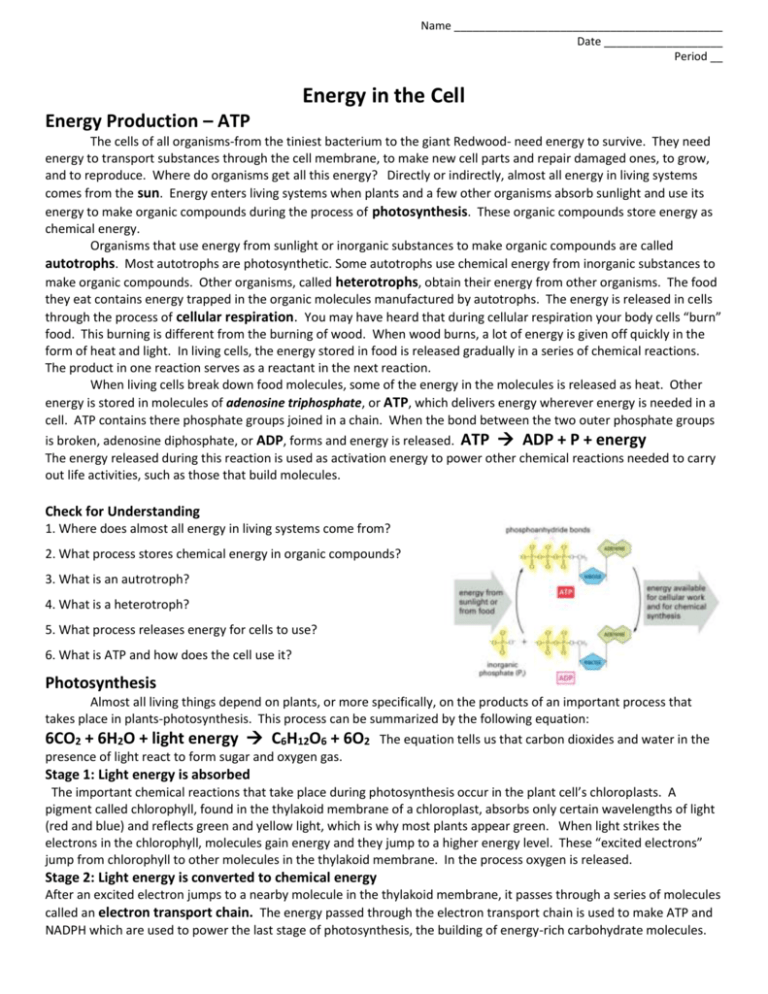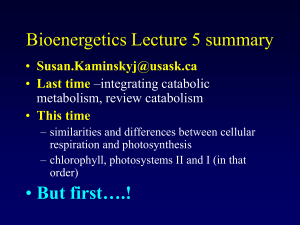Energy In The Cell Worksheet
advertisement

Name ___________________________________________ Date ___________________ Period __ Energy in the Cell Energy Production – ATP The cells of all organisms-from the tiniest bacterium to the giant Redwood- need energy to survive. They need energy to transport substances through the cell membrane, to make new cell parts and repair damaged ones, to grow, and to reproduce. Where do organisms get all this energy? Directly or indirectly, almost all energy in living systems comes from the sun. Energy enters living systems when plants and a few other organisms absorb sunlight and use its energy to make organic compounds during the process of photosynthesis. These organic compounds store energy as chemical energy. Organisms that use energy from sunlight or inorganic substances to make organic compounds are called autotrophs. Most autotrophs are photosynthetic. Some autotrophs use chemical energy from inorganic substances to make organic compounds. Other organisms, called heterotrophs, obtain their energy from other organisms. The food they eat contains energy trapped in the organic molecules manufactured by autotrophs. The energy is released in cells through the process of cellular respiration. You may have heard that during cellular respiration your body cells “burn” food. This burning is different from the burning of wood. When wood burns, a lot of energy is given off quickly in the form of heat and light. In living cells, the energy stored in food is released gradually in a series of chemical reactions. The product in one reaction serves as a reactant in the next reaction. When living cells break down food molecules, some of the energy in the molecules is released as heat. Other energy is stored in molecules of adenosine triphosphate, or ATP, which delivers energy wherever energy is needed in a cell. ATP contains there phosphate groups joined in a chain. When the bond between the two outer phosphate groups is broken, adenosine diphosphate, or ADP, forms and energy is released. ATP ADP + P + energy The energy released during this reaction is used as activation energy to power other chemical reactions needed to carry out life activities, such as those that build molecules. Check for Understanding 1. Where does almost all energy in living systems come from? 2. What process stores chemical energy in organic compounds? 3. What is an autrotroph? 4. What is a heterotroph? 5. What process releases energy for cells to use? 6. What is ATP and how does the cell use it? Photosynthesis Almost all living things depend on plants, or more specifically, on the products of an important process that takes place in plants-photosynthesis. This process can be summarized by the following equation: 6CO2 + 6H2O + light energy C6H12O6 + 6O2 The equation tells us that carbon dioxides and water in the presence of light react to form sugar and oxygen gas. Stage 1: Light energy is absorbed The important chemical reactions that take place during photosynthesis occur in the plant cell’s chloroplasts. A pigment called chlorophyll, found in the thylakoid membrane of a chloroplast, absorbs only certain wavelengths of light (red and blue) and reflects green and yellow light, which is why most plants appear green. When light strikes the electrons in the chlorophyll, molecules gain energy and they jump to a higher energy level. These “excited electrons” jump from chlorophyll to other molecules in the thylakoid membrane. In the process oxygen is released. Stage 2: Light energy is converted to chemical energy After an excited electron jumps to a nearby molecule in the thylakoid membrane, it passes through a series of molecules called an electron transport chain. The energy passed through the electron transport chain is used to make ATP and NADPH which are used to power the last stage of photosynthesis, the building of energy-rich carbohydrate molecules. Name ___________________________________________ Date ___________________ Period __ Stage 3: Chemical energy is stored in organic compounds The ATP and NADPH molecules only store energy for a short time. In the third stage of photosynthesis, carbon atoms from carbon dioxide in the atmosphere are used to make organic compounds in which energy is stored. The conversion of carbon dioxide to organic compounds is called the Calvin cycle. Three-carbon sugars are produced using energy supplied by ATP and NADPH. The three carbon sugars can be further used to produces sugars and starches. Check for Understanding 7. What is the chemical reaction for photosynthesis? 8. What pigment absorbs sunlight and where is it found? 9. What do the electron transport chains makes with the excited electrons? 10. Which stages occur only in the presence of light? 11. What process converts carbon dioxide into organic compounds? 12. Can sugars be made when light is not available? Explain Cellular Respiration The energy stored in the organic compounds that plants make is available for other organisms to use. But before that energy can be used, it must be transferred to ATP through a process called cellular respiration. The breakdown of one organic compound, glucose, can be summarized by the following equation: C6H12O6 + 6O2 6CO2 + 6H2O + Energy (ATP) This equation tells us that sugar and oxygen react in the presence of enzymes to produce carbon dioxide, water, and energy which is stored in ATP. Cellular respiration occurs in two stages. In the first stage, glucose is broken down in the cytoplasm in a process called glycolysis. During glycolysis, glucose is broken down into two smaller molecules of pyruvate. This reaction also produces small amounts of ATP and NADPH. Glycolysis is followed by another set of reactions that use the energy temporarily stored in NADPH to make more ATP. When oxygen is present, pyruvate and NADPH are used to make a large amount of ATP in a process called aerobic respiration. This is the second stage of cellular respiration. Aerobic respiration occurs in the mitochondria of eukaryotic cells and in the membranes of prokaryotic cells. When oxygen is not present, pyruvate is converted to either lactic acid or ethyl alcohol and carbon dioxide by the process of fermentation. Check for Understanding 13. What is the chemical reaction for respiration? 14. What does respiration produce? 15. What process breaks down glucose into pyruvate? 16. What process happens when oxygen is present? 17. In what organelle does aerobic respiration occur? 18. What chemicals are produced when oxygen is not available? True or False (correct statement if false) 19. Nearly all life on earth is dependent upon the process of Photosynthesis. 20. Only organisms that are unable to photosynthesize use the process of respiration to obtain energy.









